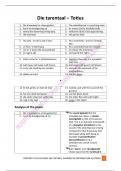Die tarentaal – Totius
1. Die kruiwawiel se skreeugeluid 1. The wheelbarrow’s screeching noise
2. kerm hy droefgeestig uit 2. he moans just as wistfully/sadly
3. terwyl die skeemring vinnig daal, 3. whilst the dusk is fast approaching,
4. die tarentaal. 4. the guinea fowl.
5. Hy soek – en dit is ook al laat - 5. He is searching – and it is already
late -
6. vir hom ‘n kameraad, 6. for a comrade/mate for himself,
7. om in ‘n boom die eensaamheid 7. to endure the loneliness
8. en nag te slyt. 8. and spend the night.
9. Sáám sal hul in ‘n blinkblaarboom 9. Together they will, in a roundleaf
teak tree,
10. half slaap, half waak, half droom, 10. half sleep, half guard, half dream,
11. en by die naadring van verderf, 11. and with the approach of the
end/perdition,
12. alléén nie sterf. 12. not die alone.
*
13. Ek het gemik, en met die knal 13. I aimed, and with the sound of the
gunshot
14. het een dood neergeval : 14. one fell down dead:
15. die ander vlieg met wilde krag 15. the other flies with wild might
16. wég in die nag! 16. away in the night!
Analysis of the poem
1. Die kruiwawiel se skreeugeluid (a) The sound (geluid) that the
2. kerm hy droefgeestig uit (a) wheelbarrow makes, is similar
(soortgelyk) to that of the guinea
fowl. This is an example (voorbeeld)
of a metaphor (metafoor) as the
sound of the wheelbarrow is being
compared to that the guinea fowl
(tarentaal) along with being an
example of personification
(personifikasie) since a
wheelbarrow cannot scream
(skreeu).
Both “kerm” and “droefgeestig”
shows (wys) that the tarentaal is
PROPERTY OF M SOUNES NO COPYING, SHARING OR DISTRIBUTION ALLOWED 1
, sad (hartseer) since he is yet to find
a mate/companion (maat). If he
does not find one, he will have to
face the night, and/or death (die
dood) alone: these are two of his
fears (verse).
k-alliterasie
3. terwyl die skeemring vinnig daal, (b) Notice the use of the word
“skeemring” which is supposed to
(veronderstel om) be “skemering”.
This is done for the sake of (ter wille
van) the rhythm (ritme) of the
poem.
4. die tarentaal. (b) The alone placement
(alleenplasing) and repetition
(herhaling) of the title indicate (dui
aan) the importance
(belangrikheid) of the tarentaal.
This stanza makes use of pair rhyme
(paarrym).
5. Hy soek – en dit is ook al laat – (c) The use of the parenthesis
(parentese/inlassin) is to indicate
(aan te dui) extra information
(inligting) which, in this case, is to
show (wys) that it is late in the day.
“laat” links to (word verbind aan)
the word “skeemring” in the
previous stanza to indicate that it is
late in the day.
The tarentaal is looking/searching
(soek) for something and the
explanation (verduideliking) of what
that is, is provided in the next line.
6. vir hom ‘n kameraad, (c) He is looking for a mate as he is
very lonely (eensaam).
A tarentaal only (net) has one mate
(wyfie) for life.
The word choice (woordkeuse) with
“kameraad” is interesting and
functional (funksioneel) as a
“comrade” is someone who stands
by you even when things are very
hard (swaar) which therefore links
to the tight bond (hegte band)
between the tarentale and also
PROPERTY OF M SOUNES NO COPYING, SHARING OR DISTRIBUTION ALLOWED 2





